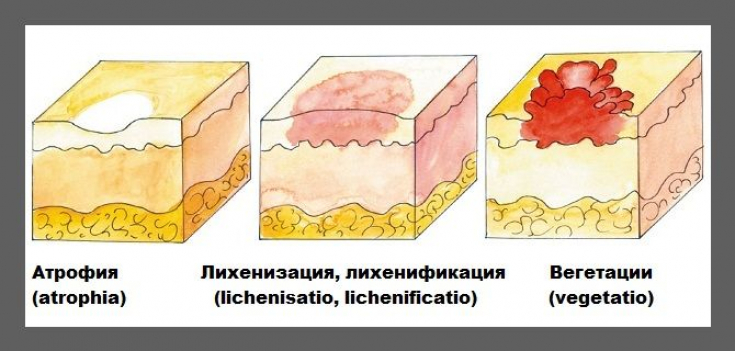Very often, dermatologists need to differentiate dermatoses that are clinically similar to each other. In this case, the resolution of the primary elements of the rash will help confirm a particular diagnosis.
As a rule, such elements appear at the site of primary lesions in the stage of remission of the disease.
Secondary morphological elements are important evidence of pathological processes in the skin or mucous membranes.
On estet-portal.com read about the types of secondary elements of the rash, and also as a result of which these skin defects.
may developHyperpigmented and depigmented spots: causes
Among the secondary elements, secondary pigmentations, cracks, erosions, excoriations, ulcers, crusts, scales, scars, lichenifications, and also vegetations are distinguished.
Secondary hypo- or hyperpigmentation – this is a change in skin color at the site of primary (nodules, pustules) or secondary (erosions, excoriations) elements or at the site of injuries with hemorrhages.
Due to the deposition of hemosiderin or melanin, the skin acquires a stagnant red color. Secondary depigmented spots occur as a result of a decrease in the amount of melanin in the areas of the primary elements of the rash.
These spots are often found in the regressive stage of psoriasis (psoriatic pseudoleukoderma) or after resolution of lichen multicolor.
Follow us also on Facebook
Cracks and abrasions: after what diseases do defects appear
Crack – this is a linear skin defect within the upper layers of the epidermis, dermis and mucous membrane, which occurs as a result of a decrease in skin elasticity.
There are superficial (fissure) within the epidermis and deep (rhagas) cracks, which are localized within the papillary layer.
Fissures occur in patients with chronic eczema, athlete's foot, neurodermatitis, or congenital syphilis. Abrasion (excoriation) or excoriation is a violation of the integrity of the skin as a result of mechanical impact on it during scratching.
With a deep location of the abrasion, a scar is formed. Excoriations often accompany itching dermatoses (scabies, neurodermatitis) and are objective evidence of the disease. Also, abrasions are found in mental disorder – pathomimia.
Patomimia: neuroses and psychotic disorders in the practice of a dermatologist
Erosions and ulcers: causes and varieties of morphological elements
erosion (erosio) – superficial defect of the skin or mucous membrane, which occurs as a result of a rupture of the covering of the cavity elements or trophic disorders in the epidermis due to the occurrence of an infiltrate in the dermis.

The element may be red or pink in color and has a moist surface, and after healing does not leave permanent changes.
Ulcer (ulcus) – deep defect of the skin or mucous membrane, which occurs due to necrosis or purulent fusion of the primary manifestations.
The bottom and edges are distinguished in the ulcer: the bottom can be uneven (with chronic ulcerative pyoderma) or smooth (hard chancre with syphilis), as well as covered with secretions, necrotic plaque or granulations.
These morphological elements may have undermined, saucer-shaped or clear edges.
After regression of ulcers, persistent changes always remain – scars.
Scales and crusts: hyperkeratotic morphological elements
Squama (squama) – stratum corneum, prone to separation from the stratum corneum as a result of the loss of intercellular connections with it.
There are: physiological peeling (occurs regularly) and pathological (erythroderma, ichthyosis, exfoliative cheilitis).

Crust (crusta) – product of drying on the skin or mucous membrane of serous exudate, pus or blood. When layered one on top of the other, the crusts are called rupees.
Depending on the size of the crusts, bran-like, lamellar and large-lamellar elements are isolated.
The color of the crusts depends on the nature of the secretion: serous exudate has a pale yellow color, purulent – yellow or greenish, hemorrhagic – red or brown.
Elements can be placed on the red border of the lips and skin (pemphigus, cheilitis, psoriasis, scabies, mycoses).
Scars, lichenification and vegetation: what are these elements
Secondary morphological features also include scarring, lichenification and vegetation. Scar (cicatrix) – it is the result of a compensatory-regenerative process, which is located at the site of the destroyed dermis, subcutaneous fat or mucous membrane.
The element is a coarse fibrous connective tissue and is formed from collagen fibers.
As a rule, scars occur when deep pustules, ulcers, cracks and excoriations resolve.
Depending on the level of location, scars are atrophic, normotrophic and hypertrophic.
Fresh elements are red or pink, older – become hyper- or depigmented.
Vegetation (vegetationes) - papillary growths of the skin or mucous membrane in the area of a prolonged inflammatory process.
The appearance of vegetations is typical for vegetative pemphigus (wet vegetation), as well as with genital warts (dry vegetation).
Accession of a secondary infection is accompanied by pain, hyperemia and the release of serous-purulent exudate.
Lichenification (lichenisatio) – skin changes that are characterized by a sharp increase in the skin pattern, hyperpigmentation, dryness, roughness.
This phenomenon is typical for chronic pruritic dermatoses: chronic eczema, neurodermatitis, atopic dermatitis.
Thank you for staying with estet-portal.com. Read other interesting articles in the "Dermatology" section. You may also be interested in: Acne scars in modern cosmetology – problem solved







Add a comment